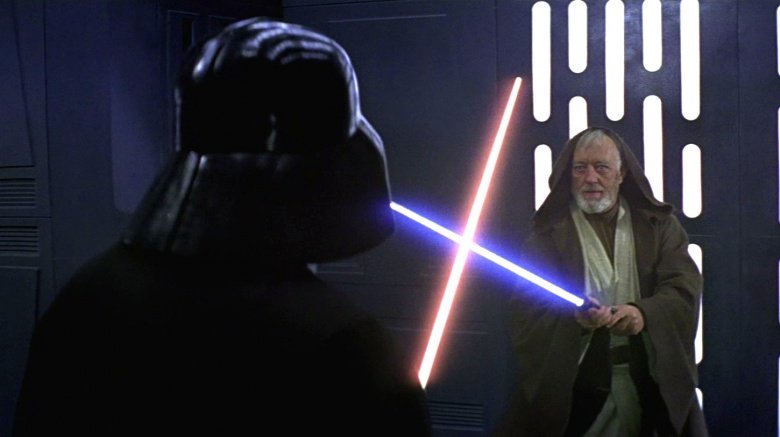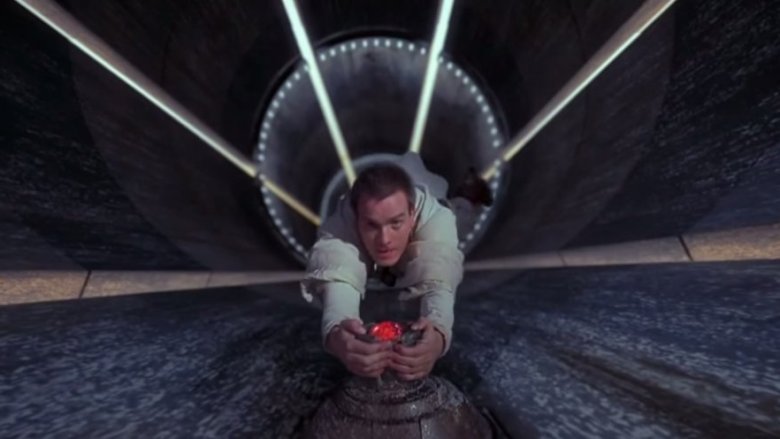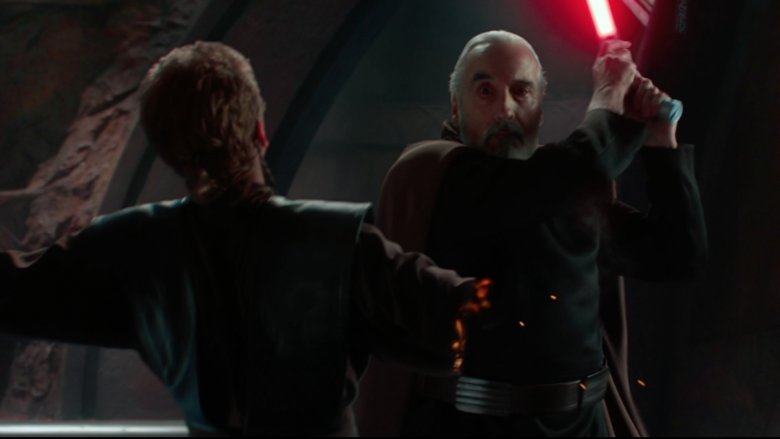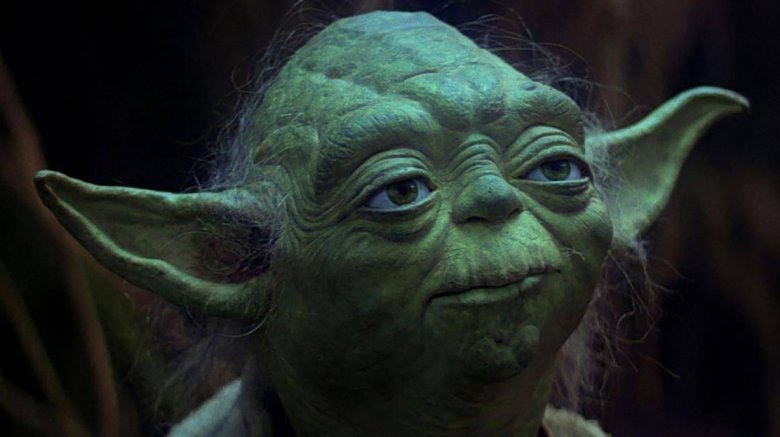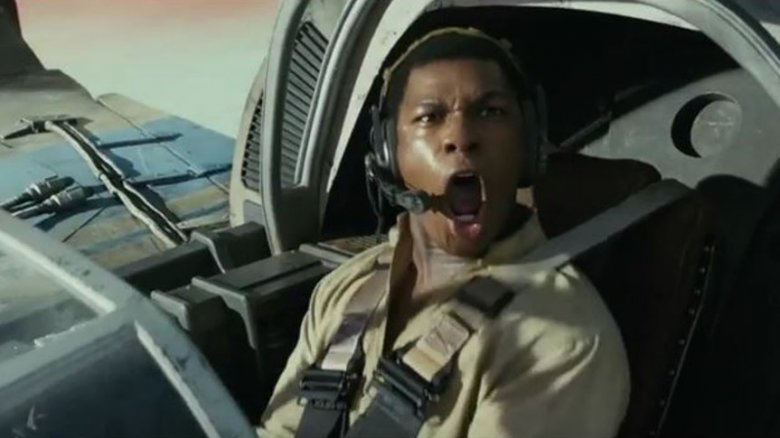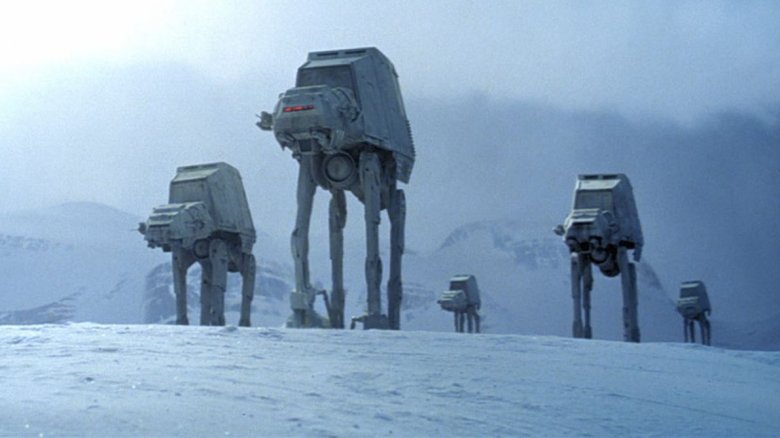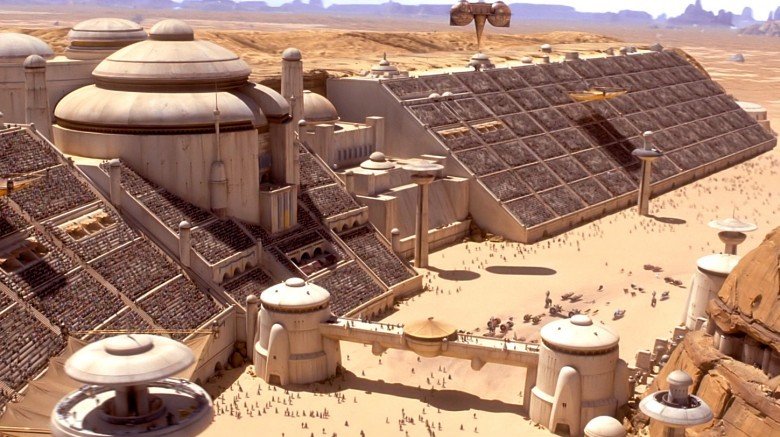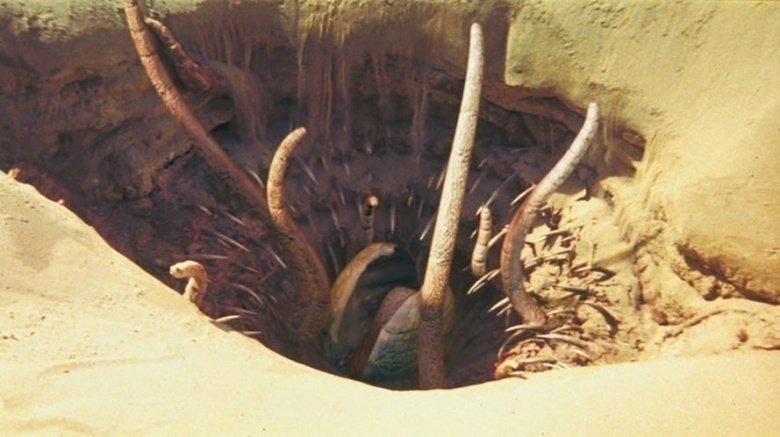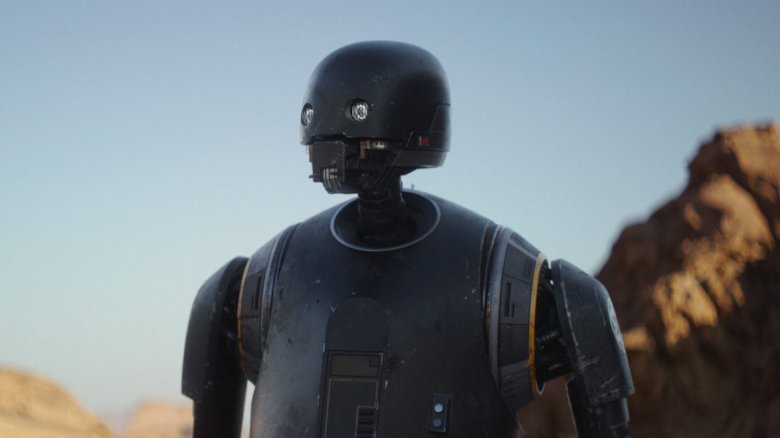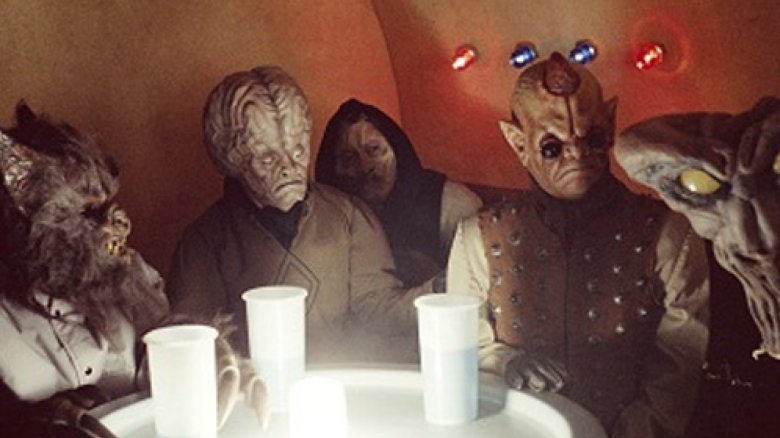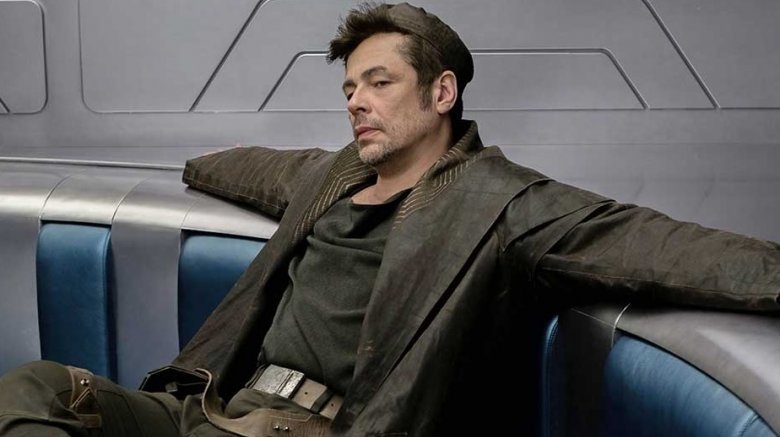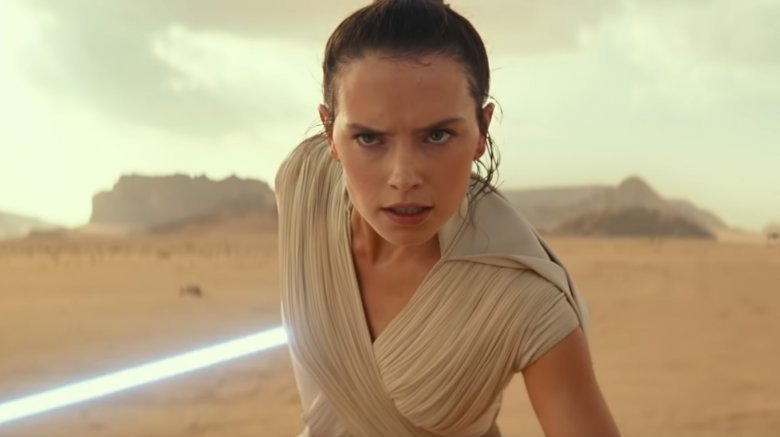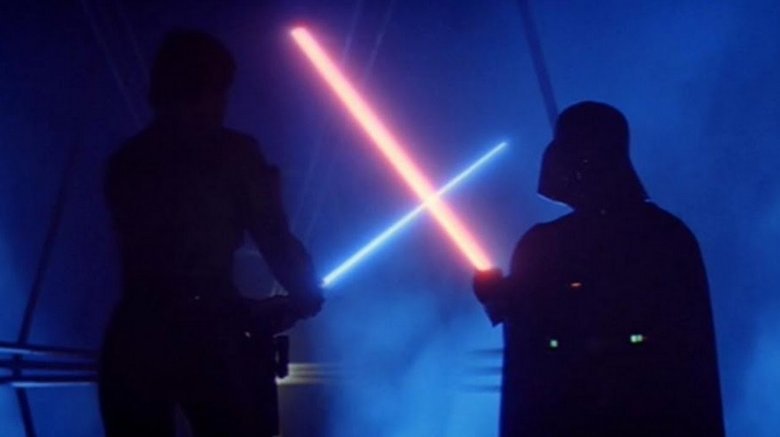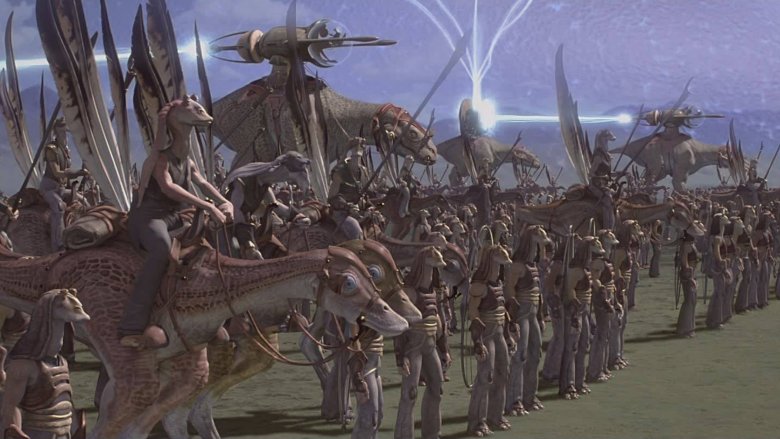These Things Happen In Every Star Wars Movie
Long-running franchises succeed, in part, because of the sense of the familiar they give their fans. They're also one of the reasons why handling a movie series like Star Wars can be so challenging. Star Wars creators walk the narrow line of bringing you back to a familiar narrative, while at the same time introducing just enough fresh elements — if there's too much new stuff, fans complain it doesn't feel like Star Wars, and if there's too little, then viewers say they were subjected to a carbon copy.
Star Wars enjoys an exalted enough status in popular culture that you don't need to be a hardcore fan to recognize most of its tropes. Even without the prologue crawl or the classic "A long time ago..." text that precedes most entries, most of us could be dragged into a theater showing a Star Wars film we've never seen and we'd still know what we were watching within moments. From the music to the signature camera moves and the particularly Star-Wars-flavored sound effects of laser blasts or distortion amidst comm traffic, you'd probably know what you were watching before one of the characters even showed up on the screen.
Keep reading to be reminded of things you know to expect in every Star Wars movie — and maybe learn about a few new ones you never noticed.
Bottomless shafts
If Star Wars films were documentaries, its many scenes featuring seemingly bottomless, lighted shafts with nebulous purposes would prove that every single Star Wars character is an absolute idiot. Something really bad happens pretty much every time one of these cavernous drops appears. If the heroes were real people then they would've learned by now that when they walk into a room with a bottomless shaft, they need to turn the hell around and run.
Qui-Gon (Liam Neeson) meets his violent end at the foot of one of these impossibly long tunnels in Phantom Menace. Both halves of Darth Maul (Ray Park) plummet down one of those shafts, just like Darth Vader (David Prowse/James Earl Jones) hurls the Emperor (Ian McDiarmid) down one in Return of the Jedi. Luke (Mark Hamill) miraculously survives a drop down Cloud City's bottomless shaft in Empire Strikes Back, and Obi-Wan (Alec Guinness) makes like Assassin's Creed over one to turn off the Death Star's tractor beam in A New Hope. We all wish Han Solo (Harrison Ford) had run once he saw the drop in The Force Awakens, but thankfully the heroes of Rogue One don't run and instead climb up one to get the Death Star plans.
The bottomless shafts of Star Wars are legion, and if you see one, you're in trouble. Enough trouble that it deserves some kind of silly mnemonic device or rhyme to remind people. If you don't see floor, don't be there anymore. Something like that.
A farewell to arms
Star Wars movies are bad for limbs and very kind to black market prosthetics dealers. Someone loses a limb in most entries. And that's true right away whether you're talking chronological by order of theatrical release or by order of the fictional events.
Darth Maul loses everything below his waist in Phantom Menace and is revealed to have survived the ordeal in the Star Wars: The Clone Wars animated series, and even makes a cameo in Solo: A Star Wars Story. Anakin (Hayden Christensen) says goodbye to the first of many soon-to-be-lost limbs when Count Dooku (Christopher Lee) relieves him of an arm in Attack of the Clones, and he loses the remaining arm and both legs in Revenge of the Sith. No major characters lose limbs in A New Hope, though Obi-Wan does leave a cantina bully's bloody arm on the bar (and later Kenobi loses his entire body). Luke takes off a Wampa's hairy arm in Empire Strikes Back, his father sends Luke's hand spinning down a shaft later in the film, and Luke pays him back by taking off one of Vader's already replaced hands in Return of the Jedi.
Neither of the newest trilogy's released entries feature limb loss, but both had deleted scenes with amputations. Chewbacca (Peter Mayhew) tears off Unkar Plutt's (Simon Pegg) arm in a snipped Force Awakens scene, and originally The Last Jedi had Captain Phasma's (Gwendoline Christie) hand sliced off by Finn (John Boyega) before her death.
Judge me by my size, do you?
Introduced in Empire Strikes Back, Yoda has proven to be one of the most popular and oft-quoted characters in the Star Wars mythos. From his scenes in Empire the Jedi Master earned a reputation as a font of wisdom. With the advent of CGI and the release of Attack of the Clones, the syntax-challenged Jedi was able to prove himself a badass warrior as well.
Yoda's also part of a Star Wars tradition that doesn't begin or end on Dagobah. Almost every entry in the franchise includes at least one character like Yoda — someone who initially seems physically unimpressive, but ultimately proves to not only be an expert warrior but a source of great wisdom and usually information about the mysterious Force, even when the character isn't a Jedi.
A New Hope gave us Obi-Wan, the oldest hero in the film's ragtag group who nevertheless easily saves Luke from Ponda Baba (Tommy Ilsley) and later fights Darth Vader in a lightsaber duel. Yoda fills the role in both Empire and Return of the Jedi, as well as appearing in all of the prequel films. Chirrut Îmwe (Donnie Yen) is arguably the most formidable hand-to-hand combatant to appear in Rogue One as well as being the loudest voice of the Force in the film. The enigmatic Maz Kanata (Lupita Nyong'o) plays the part in the newest trilogy, even though her connection to the Jedi, if there is any, hasn't been revealed.
WAHOO!!
People have a lot of fun driving and flying stuff in Star Wars. We're not suggesting they shouldn't have fun, especially since there's always a good chance they're just a few minutes away from having their arms chopped off and thrown down a bottomless shaft. They should take advantage of what fun they can. We're just saying there's a lot of yelling "WAHOO" in Star Wars, both during and after the reign of George Lucas. Wahoo and yee-ha and lots of other loud onomatopoeias, usually while flying something, and usually while being ruthlessly fired at by multiple enemies.
Whether it's Han celebrating finally taking out a TIE fighter (right before telling Luke to not get "cocky") or even the young Anakin Skywalker (Jake Lloyd) belting out the occasional "wahoo" while threading through Trade Federation droid fighters, Star Wars heroes yell the stuff. A lot. Even when they're having a really bad day. Even Finn, when he first escapes the clutches of the First Order with Poe (Oscar Isaac), is wahooing up and down the dark void of space as he and his new buddy narrowly escape death.
They're always yelling. And usually? They're yelling right in the comm microphones. It's a mystery why Red Leader and Gold Leader and all the other Leaders aren't constantly telling them to shut up.
Planets of extremes
While the Star Wars galaxy boasts a wide variety of planets, the planets themselves don't offer a lot of varied climates and terrain.
The worlds of Star Wars tend to be planets of extremes. While our own Earth has some deserts, for example, if there's a desert on a planet in a Star Wars film then it's likely because the entire planet is a desert like the recurring setting of Tatooine or Force Awaken's Jakku. If there's ice and snow on the planet, there's ice and snow everywhere, like frigid Hoth in the beginning of Empire Strikes Back. There's the swamp planet Dagobah, the ocean planet Kamino, and the everything-looks-like-a-volcano planet Mustafar in Revenge of the Sith. The final location in Return of the Jedi is even referred to as the "Forest Moon of Endor," in case visitors aren't sure of what extreme and singular environment to expect.
Being a travel agent in a Star Wars movie must either be really easy or really tough. On one hand, if your clients want one specific climate, you've got tons of choices. But if they say something like "Well, I want to do some sailing and some skiing, but I don't want to leave the planet to do either," then you're going to end up sobbing in frustration. Or just lying a lot.
Desert planets
Speaking of extreme planets — no matter what the story is or who the lead is, the Star Wars story keeps bringing us back to one of two desert planets. Usually it's Tatooine, though it's replaced by the equally desolate and arid Jakku in The Force Awakens. Even The Rise of Skywalker is poised to add to Star Wars' roster of desert planets, with the strange, rocky world of Pasaana.
It's a little surprising Tatooine features quite so much in the Star Wars mythos, if for no other reason than a series set in a galaxy chock full of planets inhabited by intelligent life keeps swinging back to the same dry ball of sand.
While the question of Tatoine's specific connection to the Force has yet to be directly addressed in the films, it would be surprising if its recurring appearance has nothing to do with a strong connection to the Force. From both Luke's training on Dagobah in Empire Strikes Back and Rey's (Daisy Ridley) training on Ahch-To in The Last Jedi, we know certain places in the universe are particularly strong with the Force. Considering Tatooine is the birthplace of Anakin Skywalker, the childhood home of Luke Skywalker, and the decades-long hiding place of Obi-Wan Kenobi, its connection to the Force is probably significant to say the least.
Hidden titans
The universe is a big place and in the Star Wars galaxy, it hides many titans.
Star Wars boasts enough giant monsters to fill the cast of any Godzilla flick. Unlike most of the monsters in Godzilla, though, Star Wars titans are really good at hiding; amazingly good, considering their size. Often the monsters of Star Wars appear as naturally occurring parts of the terrain. Most famously, there's the Mighty Sarlacc of Return of the Jedi who swallows Boba Fett and dozens of Jabba the Hutt's henchmen. From afar Sarlacc looks like nothing more than a huge hole in the ground, but once you get close enough you spot the teeth and the tendrils, and by then you're probably lunch. Equally sneaky is the gargantuan space slug of Empire Strikes Back who almost makes a meal of the heroes when Han mistakes the beast's insides for a cave.
We never see most of the dianoga — the beast who almost drags Luke to his death in the trash compactor scene of A New Hope. The Rancor, though not exactly as cleverly hidden as the Sarlacc or the space slug, is kept out of our sight so we're left to imagine the thing we hear waiting below Jabba's palace in Return of the Jedi. There are the multiple aquatic giants who threaten the heroes as they navigate Naboo's waterways in Phantom Menace. And of course there's the massive tentacled Summa-verminoth who tries to eat the Millennium Falcon in Solo.
Droids are the worst
Droids don't do what droids are supposed to do. Or, as is perhaps the more common occurrence, they do what they're supposed to do but only after complaining about it for a really long time. C-3P0 (Anthony Daniels) is constantly arguing against the heroes' plans, and R2-D2 (Kenny Baker) has more secret side quests than Skyrim. In Rogue One, K-2SO (Alan Tudyk) second-guesses all of Cassian's (Diego Luna) decisions and sets himself up as the authority on who can and who cannot be trusted, while in Solo, L3 (Phoebe Waller-Bridge) is more concerned with starting a droid revolution than with being helpful.
Ironically, perhaps the best evidence of this is the rare example of a droid doing what it's supposed to do. In Phantom Menace, R2-D2 is introduced as one of a number of droids dispatched to repair Queen Amidala's (Natalie Portman) ship while under fire. R2 is the only droid to survive and manages to fix the ship's hyperdrive. Later, Amidala thanks the droid for its service and orders it be specially cleaned as a reward. Which means, apparently, a droid doing precisely what it was designed to do is such a rare occurrence in the Star Wars narrative that when it actually happens, any nearby humans feel the need to set up a freaking awards ceremony.
Hives of scum and villainy
The Mos Eisley Cantina from A New Hope is the setting of one of the franchise's most well-remembered scenes and it's one of the most often copied. Similar hives "of scum and villainy" can be found in just about every Star Wars film.
Jabba's palace in Return of the Jedi is a larger, grander version of the Mos Eisley Cantina. In one of Attack of the Clones' few genuinely funny moments, Obi-Wan uses his Jedi mind trick to convince a drug dealer in a bar on Coruscant that not only does the young man not want to sell him Death Sticks, but he wants to change his life for the better. Fittingly, Solo features almost nothing but these places of ill repute, starting with the crime boss lair Han escapes on Corellia, the casino on Vandor where Han first meets Lando (Donald Glover), and later the bar on Numidian Prime where Han finally wins the Millenium Falcon from Lando. Shortly after Han meets Finn and Rey in The Force Awakens, he brings them to Maz Kanata's cantina-esque castle on Takodana. And while its leader and soldiers were extremist rebels, Saw Gerrera's (Forest Whitaker) stronghold on Jedha felt a lot like Jabba's Palace.
Then there are examples that seem more "upscale," but nevertheless are just as villainous like Dryden Vos' (Paul Bettany) yacht in Solo and the casino catering to the super rich on Canto Bight in The Last Jedi.
Scoundrels
Obviously if you're going to have a bunch of hives of scum and villainy, you're going to need some scum and villainy to help populate the hives. The Star Wars mythos has no shortage of smugglers, bounty hunters, organized crime bosses, and other crooks.
Han Solo plays at being a picture of apathy in the face of the Empire's crimes, but eventually his heroism shines through. Lando (Billy Dee Williams) joins him in Empire Strikes Back, and Solo introduces us to even more scoundrels like Beckett (Woody Harrelson) and Val (Thandie Newton). Cassian of Rogue One is a different kind of scoundrel. While Solo acts as if he only cares about himself but nevertheless always winds up doing the right thing, Cassian tends to do the wrong thing for completely unselfish reasons, like when he murders another rebel operative in the beginning of Rogue One to stop him from being captured and revealing rebel secrets. Or when he becomes more than willing to murder Galen Erso (Mads Mikkelsen) for the sake of the rebellion.
One of the most recent additions to Star Wars' famous scoundrels is DJ (Benicio del Toro) in The Last Jedi. With DJ, the storytellers turned the usual figure of the Star Wars scoundrel on its head. We're led to believe DJ is another hero playing at selfishness, but he turns out to actually be a piece of garbage — betraying Finn and Rose (Kelly Marie Tran) to the tender mercies of the First Order.
Mysterious births
One of the funniest ironies of the Star Wars saga is how many major characters in the stories have no idea who their parents are. In our comparatively technologically primitive real world, just about anyone in the United States could mail a DNA sample off and potentially find out what part of Africa their ancestors hailed from. And any sensationalist talk show host can hire a lab to find out who the real baby daddy is. Yet in a galaxy far, far away where even the crappier ships can travel at the speed of light, no one seems to have heard of DNA testing.
While speculation about Rey's parents is still running wild, she's hardly the first character in the saga to face a mystery surrounding her birth. Luke Skywalker learns Darth Vader is his father at the end of Empire Strikes Back, and Leia (Carrie Fisher) — who, unlike Luke, meets who she believes to be her biological father and has less reason to believe there was anything mysterious about her birth — learns she's Luke's sister in Return of the Jedi.
Of course, there's Vader himself. In Phantom Menace Anakin's mother Shmi (Pernilla August) tells Qui-Gon her son has no biological father. One day she wasn't pregnant, the next day she was, without any inciting event. She just had a baby. Like having a cold.
Fun with laser swords
No lightsaber in a Star Wars movie is like no kicking in a kung fu movie. In the earliest films, the duel takes place toward the end. Obi-Wan battles Vader in A New Hope, Luke's Empire Strikes Back struggle with Vader is perhaps the most desperate of all the duels, and once he's fully trained Luke proves his skills superior to Vader's in Return of the Jedi.
The prequels brought us the beautifully choreographed battle between Darth Maul, Qui-Gon, and Obi-Wan in Phantom Menace. Obi-Wan and Anakin are both humbled by Count Dooku in Attack of the Clones, though they're saved when we get our first look at Yoda's insane lightsaber skills. Revenge of the Sith was the first film to give us a duel right in the beginning — a rematch between Anakin and Dooku — along with the Jedi Council's doomed attempt to capture Palpatine, General Grievous' (Matthew Wood) four-armed assault on Obi-Wan, and Kenobi's victory over Anakin on Mustafar.
The Force Awakens is the first time we get to see a woman on either side of a lightsaber duel as Rey takes on Kylo Ren (Adam Driver), after the latter easily defeats Finn. There's little saber-on-saber action in The Last Jedi. Kylo and Rey fight back-to-back against Snoke's (Andy Serkis) Elite Praetorian Guard, Phasma has an energy baton rather than a lightsaber when Finn attacks her, and the Luke who faces Kylo at the end of the film turns out to not actually be there.
Layered wars
Star Wars climaxes tend to follow the formula of a huge, multi-layered battle. There's a larger battle made up of two or three smaller battles. There's always at least one grand military clash, and then a more personal one-on-one fight. Return of the Jedi establishes the formula. On Endor the Ewoks and the rebel ground forces fight the Imperial troops to take out the Death Star's shield generators, in space the rebel fleet clashes with the Imperial TIE fighters and Star Destroyers, while on the Death Star Luke and Vader cross lightsabers one last time.
The formula returns in Phantom Menace. The amphibious Gungan army faces off against the droids on Naboo, Obi-Wan and Qui-Gon have their fateful duel with Darth Maul in the Palace, while Naboo fighters battle the Trade Federation's droid ships in space. Likewise the end of The Force Awakens is split between the rebel fleet's attempt to take out Starkiller Base and the lightsaber duel in the snow. Rogue One's tragic final clash shows yet another fight in space, a large-scale ground assault, and the efforts of Jyn, Cassian, and K2SO to find and transmit the Death Star plans.
Revenge of the Sith is one of the few entries to not include a huge military battle — instead going back and forth between the Obi-Wan/Vader duel on Mustafar and the fight between Yoda and Palpatine on Coruscant.
